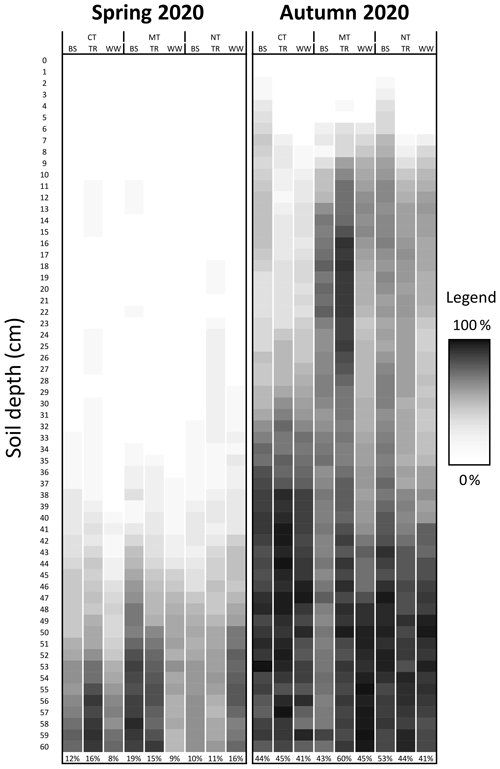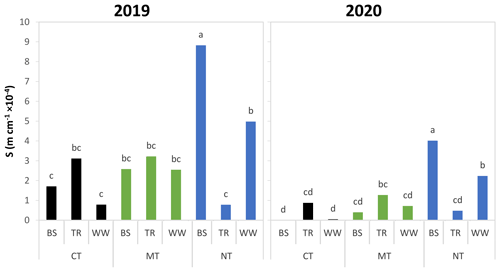the Creative Commons Attribution 4.0 License.
the Creative Commons Attribution 4.0 License.
Transition to conservation agriculture: how tillage intensity and covering affect soil physical parameters
Felice Sartori
Riccardo Polese
Antonio Berti
Conservation agriculture (CA) relies on the following three key practices to improve agricultural sustainability: crop rotation, reduced tillage, and cover crop usage. Despite known soil physical benefits (reduced soil compaction and strength, enhanced soil porosity, and permeability), inconsistent reports on short-term CA results have limited its adoption in the European agroecosystems. To elucidate the short-term effects, a 3-year field experiment was undertaken in the low-lying Venetian plain (northern Italy). Bulk density (BD), penetration resistance (PR), soil hydraulic saturated conductivity, and sorptivity were used to evaluate soil quality obtained by combining three tillage intensities (conventional tillage – CT; minimum tillage – MT; no tillage – NT) with three winter soil coverings (bare soil – BS; tillage radish cover crop – TR; winter wheat cover crop – WW). Among the tillage methods, CT, on average, reduced BD by 4 % (from 1.48 to 1.42 g cm−3) and PR by 3.1 % (from 1.69 to 1.64 MPa) in the 0–30 cm tilled layer. Across the soil profile, reduced tillage coupled with WW improved soil physical properties even below the tilled layer, as evidenced by root-growth-limiting condition reductions (−11 % in BD values, with BD >1.55 g cm−3, and −7 % in PR values, with PR >2.5 MPa). Soil hydraulic measurements confirmed this positive behaviour; NT combined with either BS or WW produced a soil saturated conductivity of m s−1 (4 times that of all other treatments). Likewise, sorptivity increased in NT combined with BS vs. other treatments ( m s−1 vs. an all-treatment average of m s−1). Our results suggest that, despite the increase in BD and PR due to reduced tillage, the strategy improved soil functioning and particularly soil hydraulic conductivity. In the short term, the WW cover crop moderately increased physical soil parameters, whereas TR had negligible effects. This study demonstrates that, to quantify CA, several soil physical parameters should be monitored.
- Article
(2198 KB) - Full-text XML
- BibTeX
- EndNote
Minimal soil disturbance, permanent soil covering, and crop rotation represent the main pillars of conservation agriculture (CA; FAO, 2017). Adoption of CA not only leads to reduced labour and farm costs but also provides several ecosystem services that increase agroecosystem sustainability. Its hallmarks of reduced soil tillage, applied cover crops (CCs), and crop rotation generally foster nutrient cycling and soil biological activity (Hobbs et al., 2008) and improve soil structure along the full soil profile, while protecting soil organic matter (Hobbs, 2007; Thomas et al., 1996).
Despite a growing interest in CA from many agroecosystems, and especially in the Americas, European adoption of the practice has faltered (Kassam et al., 2019). One reason behind limited CA adoption in Europe is uncertainty about its effects during the transitional period after conversion from conventional to conservation agriculture (Pittelkow et al., 2015; Rusinamhodzi et al., 2011).
Negative reports of the short-term effects of CA on physical soil parameters were previously observed in no tillage (NT) on bulk density (BD; Guan et al., 2014), soil strength (Munkholm et al., 2003; Palm et al., 2014), and soil saturated hydraulic conductivity (Buczko et al., 2006). Nevertheless, the management of the fallow period between two main crops (e.g. bare soil or the adoption of cover crops) can affect the soil evolution (Blanco-Canqui and Ruis, 2018). In the low-lying Venetian Plain of northern Italy, soils contain low organic carbon, high levels of carbonate, and are micro-structured. The principal threats to such soils are organic matter depletion and compaction (Piccoli et al., 2020). Traditionally, farmers have countered compaction with annual deep ploughing that, in the long-term, may contribute to plough pan formation and foster organic matter mineralization. During the last 2 decades, only about 1000 ha were converted to no-tillage-based CA in the region. Previous studies showed almost no effect on soil porosity and gas exchanges (Piccoli et al., 2017a, b) and on soil organic carbon (SOC) stock but rather a greater stratification in fine-textured soils (Camarotto et al., 2020; Piccoli et al., 2016), while some compaction-related issues were visible in coarser soils (Piccoli et al., 2020, 2021). On the other hand, through model simulation, Camarotto et al. (2018) hypothesized that the benefits of CA might require longer-term applications for their exploitation due to the soil inertia to management practices.
A valuable short-term solution to facilitate the conversion from conventional agriculture to CA is the introduction of CCs. If cash crops are grown during the spring and summer, then autumn-drilled CCs must develop rapidly to cover the soil before winter, and devitalization must occur in the spring before cash crop seeding. Typically, CCs are used to maintain soil coverage. It consists of cultivating plants between two main crops, leaving the entire biomass on the field after the growing season, and eventually burying it before the subsequent crop is planted (Schipanski et al., 2014). The use of CCs is a pivotal strategy for enhancing soil physical properties in reduced tillage systems (Blanco-Canqui et al., 2011). Nevertheless, an efficient use of CCs requires careful selection of species, seeding date, and management strategy (Daryanto et al., 2018). Differing species may positively impact nutrient cycling, soil properties, and/or weed suppression, although such factors must be cost-effective, since they do not contribute directly to profitability (Ranaldo et al., 2019; Schappert et al., 2019). Suitable CC species for northern Italy agroecosystems are Poaceae (e.g. wheat, barley, oat, rye, and triticale), which already are well adapted and easily managed by farmers. Poaceae can control weeds and reduce nutrient losses. Moreover, their fibrous root apparatus can positively impact soil physical properties, especially in the shallow soil layer (García-González et al., 2018). Alternatively, to mitigate soil compaction and improve the physical quality of the soil, tillage radish (Raphanus sativus L. or TR) has been broadly applied as a CC (Ciaccia et al., 2019; Crotty and Stoate, 2019). TR is a brassicaceous plant, specifically selected to improve the macro-porosity and pore connection of the soil. Its 5 cm (D) × 30 cm (L) taproot counters soil compaction while enhancing water infiltration. While it is killed in the winter, it is easily managed in the spring (in an NT system also) (Büchi et al., 2020). As has been demonstrated by the limited use of CCs throughout northern Italy, there is a general lack of knowledge on TR adaptability in such agroecosystems and its effectiveness at improving soil properties.
The goal of this study is to evaluate soil physical traits using different measurements during the transition from conventional tillage to CA. For this purpose, BD, PR, and soil hydraulic parameters were monitored from 2018 to 2020 in a field trial combining three different tillage systems with three winter soil coverings. Our starting hypothesis is that the introduction of reduced tillage systems is expected to negatively impact on the studied soil physical properties, but its combination with tillage radish should be able to alleviate these drawbacks.
The experiment took place at the Lucio Toniolo Experimental Farm, located in Legnaro, PD (NE Italy; 45∘21′ N, 11∘58′ E; 6 m a.s.l. – above sea level), where the climate is sub-humid, with temperatures between −1.5 ∘C on average in January and 27.2 ∘C on average in July. Rainfall reaches 850 mm annually, with reference evapotranspiration of 945 mm that exceeds the rainfall during April to September. The highest rainfall occurs in June (100 mm) and in October (90 mm), while winter is the driest season, with an average rainfall of 55 mm. The shallow water table ranges from 0.5 to 2 m in depth, with the lowest values recorded in summer.
The trial, which began in spring 2018, was designed as a split plot, with two replicates. A 2 ha area was divided into 18 elementary plots of 1.111 m2 each, allocated in two main blocks. Soil at the site is Fluvi-Calcaric Cambisol (FAO, 1981), with a silty loam texture.
At the start of the experiment, the average soil texture of each plot was determined by laser diffraction (Malvern Mastersizer 2000; Malvern Panalytical Ltd, Malvern, UK) as described in Bittelli et al. (2019). The soil texture was uniform within the experimental unit, with, on average, 25 ± 1.19 %, 57 ± 0.85 %, and 18 ± 0.36 % of sand, silt, and clay, respectively. The three different tillage treatments were randomized in the main plot, which consisted in cluster of three elementary plots, i.e. the conventional tillage (CT) main plot was ploughed to 30 cm and harrowed (15 cm), the minimum tillage (MT) main plot was arrowed to a depth of 15 cm, and the no-tillage (NT) main plot was sod-seeded. Then, three winter soil coverings were randomized in the elementary plots within each of these main plots, including TR (Raphanus sativus L.), winter wheat (WW – Triticum aestivum L.), and bare soil (BS), where no soil cover was present other than the residues from the crop of the previous year. Cover crops were drilled on the main crop residues in autumn 2018 and 2019. The main crop was always maize (Zea mays L.).
2.1 Field surveys
A total of four parameters were selected to monitor soil physical qualities, namely BD, PR, and saturated hydraulic conductivity (Ks) together with sorptivity (S). The survey timetable is shown in Fig. 1.
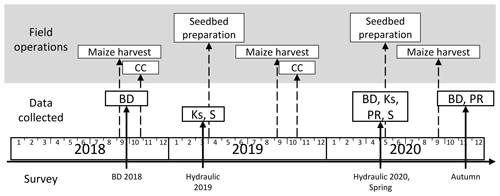
Figure 1Survey timetable. Note: BD – bulk density; CC – cover crop seeding; Ks – saturated hydraulic conductivity; PR – penetration resistance; S – sorptivity.
2.1.1 Bulk density
The surveys were conducted on three sampling dates. Measurements were first performed at the start of the experiment after the first-year harvest (2018). The second collection occurred in 2020 before tillage operations and after CC devitalization (spring 2020). The final sampling was performed in the same year, after the maize harvest, but before the soil preparation and subsequent crop seeding (autumn 2020; Fig. 1). A total of 54 undisturbed soil cores (7 cm diameter × 60 cm height) were collected during the 3-year experiment with a hydraulic sampler. Each core was then divided into six layers (7 cm diameter × 10 cm height; 385 cm3 volume), totalling 324 soil samples. All samples were oven-dried (48 h at 105 ∘C) to calculate BD with the core method (Grossman and Reinsch, 2002).
2.1.2 Penetration resistance
Penetration resistance was measured with a penetrologger (Eijkelkamp, the Netherlands), throughout the 0–80 cm layer, with a 30∘ 2 cm2 cone. In each plot, four sampling zones were randomly selected. In each sampling zone, four penetration measurements were performed within an area of 0.25 m2. Disturbed soil samples were also collected to determine the gravimetric water content and soil texture in each 20 cm soil layer (0–20, 20–40, 40–60, and 60–80 cm). The penetrologger ranged from 0 to 5 MPa. In total, two PR samplings were performed in the spring and autumn surveys and were coincident with the second and third BD measurements (Fig. 1). PR values were averaged for each 10 cm of the soil profile and compared with the 2.5 MPa threshold, which is considered a critical value above which root growth may be compromised, according to Groenevelt et al. (2001).
2.1.3 Saturated hydraulic conductivity and sorptivity
Saturated hydraulic conductivity (Ks) and sorptivity (S) parameters were calculated from the measurements of a double-ring infiltrometer on an area of 1300 cm2, as described in Morbidelli et al. (2017). Philips equations (Philip, 1969) were fitted to the field data to calculate Ks and S. In total, two surveys (spring 2019 and spring 2020; March and May, respectively) were conducted to measure these parameters after CC termination and before soil preparation, with a single measurement per plot per survey.
2.2 Statistical analyses
A mixed-effects model was applied to test the main effects of tillage, soil covering, and their interactions on all ith variables for each monitoring period. The sand content, BD, and GWC (gravimetric water content) were tested as covariates. Tillage, CCs, and depth were treated as fixed effects; the block effect was treated as random, and measurements inside the same plot were considered as nested. All possible first- and second-order interactions between factors were tested, and the model with the smallest AIC (Akaike information criterion) was selected (Schabenberger and Pierce, 2001). Prior to analyses, normality and homoscedasticity were checked through Q−Q plots and residual plots. Post hoc pairwise comparisons of least squares means were performed, using the Tukey method to adjust for multiple comparisons at p<0.05.
For PR, the percentage of measurements above 2.5 MPa along the soil profile was tested with Kruskal–Wallis analysis of variance (ANOVA), as these data were the only data that were not normally distributed. The BD–PR correlation significance was F tested. All statistical analyses were performed with SAS (SAS Institute Inc, Cary, NC, USA) version 5.1.
3.1 Bulk density
The first BD survey conducted at the beginning of the experiment (2018) showed uniform BD among the experimental plots. In the tilled layer (0–30 cm), BD ranged between 1.14 and 1.60 g cm−3 (average value of 1.40 g cm−3). In the deepest layer (30–60 cm), the mean value was higher at 1.49 g cm−3, within a range of 1.30 and 1.69 g cm−3. No statistical differences were reported among treatments (Fig. 2; Table 1).
Table 1Comparison of p values among the linear mixed-effect models analysis of bulk density (BD), penetration resistance (PR), saturated hydraulic conductivity (Ks), and sorptivity (S). Effects were considered significant if p≤0.05. Note: GWC – gravimetric water content.

The dash (–) indicates the effect not included in the model according to the Akaike information criterion. n/a stands for not applicable.
On the contrary, significant differences were reported in the spring 2020 survey. In the 0–30 cm soil layers, the CT–BS displayed the lowest BD (1.37 g cm−3 or 5.1 % lower) among all other treatments. In NT, cover crops TR and WW both seemed to reduce BD values in the 10–40 cm layer (1.54 g cm−3 on average) when compared to BS (1.58 g cm−3). Generally, a tillage effect was prevalent in the 10–30 cm soil layer (Fig. 2), where CT averaged 1.37 g cm−3, as opposed to the 6.5 % higher BD found in the same layer of MT and NT. In the deeper layers, BD was generally higher, ranging from 1.54 to 1.91 g cm−3.
The autumn 2020 BD survey exhibited a greater tillage effect along the soil profile relative to the time zero survey. The 0–10 cm BD of NT averaged 1.46 g cm−3, which is 6.6 % greater than the other treatments. In these soil layers, the presence of a cover raised BD values throughout the soil profile by 2.9 % (1.41 g cm−3). In the subsequent soil layer (10–20 cm), CT showed the lowest average BD values (1.43 g cm−3), whereas, at depths below 20 cm (20–60 cm), the CT treatment resulted in 2.2 % higher average BD values (1.57 g cm−3) when compared to the reduced tillage systems (MT and NT). In both surveys, CC did not significantly affect BD.
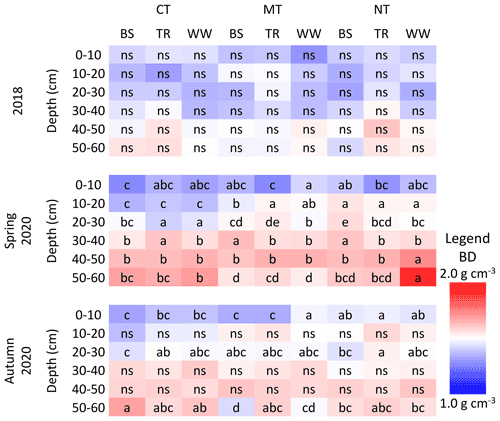
Figure 2Bulk density (BD) distribution along the 0–60 cm soil profile. For each soil layer, the letters indicate the significant effects of tillage × CCs, according to the Tukey test (p<0.05). Note: CT – conventional tillage; MT – minimum tillage; NT – no-tillage; BS – bare soil; TR – tillage radish; WW – winter wheat.
3.2 Penetration resistance
Results indicated that soil structure, soil texture, and soil water content affected PR in both 2020 surveys (Table 1). Noteworthy is the fact that the instrumental limit (i.e. 5 MPa) was often reached and eventually exceeded in the 60–80 cm layer, although only the 0–60 cm layer was considered in this study. Soil moisture conditions were, on average, drier during the autumn 2020 survey (0.163 kg kg−1) than during the spring 2020 one (0.222 kg kg−1), for which the average PR values were 2.52 and 1.58 MPa, respectively. During both surveys, significant differences were observed for tillage × depth and tillage × CC interactions (Table 1). A comparison among the three tillage systems showed that CT exhibited lower PR values than MT and NT in the 10–30 cm layer in both surveys (Fig. 3). Indeed, CT reported average PR values of 1.04 MPa (spring 2020) and 1.91 MPa (autumn 2020), while the reduced tillage treatments increased their PR values by +35.6 % (1.41 MPa) and +31.4 % (2.51 MPa), respectively.
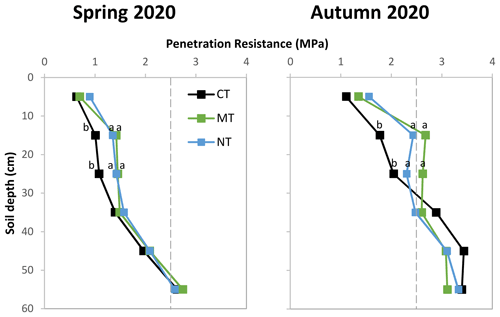
Figure 3Penetration resistance (PR) along the 0–60 cm soil profile (values averaged every 10 cm). Different letters represent significant differences according to the post hoc Tukey test (p<0.05). The vertical dashed line indicates the 2.5 MPa threshold, according to Groenevelt et al. (2001). Note: CT – conventional tillage; MT – minimum tillage; NT – no tillage.
When the entire 0–60 cm soil profile was considered, CT (regardless of the winter soil covering), MT–TR, and NT–BS were associated with the lowest PR values in the spring 2020 survey (1.50 MPa, on average; Fig. 4). The highest PR value occurred in MT–BS (1.74 MPa). Alternatively, in autumn 2020, the highest PR was measured in MT–TR (2.81 MPa), while MT–BS, CT–WW, CT–BS, and MT–WW (on average 2.42 MPa) were all among the lowest. CT–TR and the NT treatments resulted in intermediate PR values that ranged between 2.51 MPa (NT–WW) and 2.55 (NT–BS).
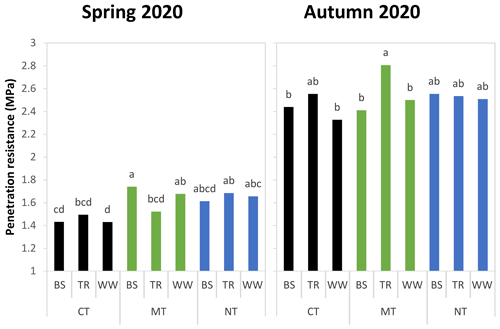
Figure 4Penetration resistance along the 0–60 cm soil profile. Different letters represent significant differences according to the post hoc Tukey test with p<0.05. Note: CT – conventional tillage; MT – minimum tillage; NT – no tillage; BS – bare soil; TR – tillage radish; WW – winter wheat.
The PR values were then compared with the 2.5 MPa limit (Fig. 5). During the first survey (spring 2020) only 13 % of measurements were above this threshold and mostly beneath the tilled layer. During the autumn 2020 survey, the proportion of measures above the threshold rose to 46 %, with a high percentage reported throughout the full soil profile. The Kruskal–Wallis one-way ANOVA resulted in a significant (p<0.05) effect related to the combination of tillage and CC. MT–TR resulted in the highest proportion of over-threshold PR values (60 %). It was followed by NT–BS (53 %), and all the other treatments ranged between 41 % and 45 %.
3.3 Soil hydraulic properties
A significant tillage × CC interaction effect was observed on Ks during both the 2019 and 2020 surveys (Fig. 6). The NT–WW treatment produced the highest 2019 Ks value, which represented a two-fold increase compared to all other treatments ( m s−1 in NT–WW vs. m s−1 in the other treatments, on average). During the 2020 survey, all treatments exhibited increased Ks values that were 1.6 times higher, on average, than those of 2019. In particular, the combination of either BS or WW with NT had the highest Ks ( m s−1), which was more than twice the values of all other treatments ( m s−1, on average). It is worth noting that TR displayed no interactions with soil tillage in either year.
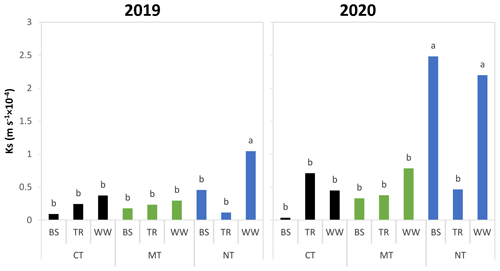
Figure 6Saturated hydraulic conductivity (Ks) as measured in the two surveys (2019 and 2020). Different letters represent significant differences according to the post hoc Tukey test (p<0.05). Note: CT – conventional tillage; MT – minimum tillage; NT – no tillage; BS – bare soil; TR – tillage radish; WW – winter wheat.
Sorptivity (S) was affected both by the interaction of tillage × CCs and soil texture (Table 1; Fig. 7). The sand content negatively correlated with S. Identical tendencies were observed in both years. Among the treatments, NT–BS reported the highest results, with m s−1 in 2019 and m s−1 in 2020. Very low values of S were observed in CT–BS ( m s−1, on average) during the 2020 survey.
3.4 Correlation between bulk density and penetration resistance
A significant (p<0.01) positive correlation was found between BD (range of 1.33–1.80 g cm−3) and PR (range of 0.5–2.5 MPa) with 0.36R2. At a PR > 2.5 MPa, no correlation with BD was detected and no other regression could be found between the two parameters. At points above the critical limits of PR (2.5 MPa) and BD (1.55 g cm−3), 46 % of the observations were detected in CT, 31 % in MT, and only 23 % in NT, as the red box highlights in Fig. 8. Under these limiting conditions, WW reported the fewest (31 %), BS intermediated (33 %), and TR the highest (36 %) number of observations.
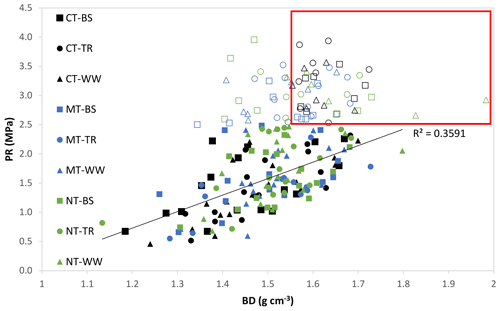
Figure 8Correlation between bulk density (BD) and penetration resistance (PR). The line represents the significant (p<0.01) linear correlation for PR < 2.5 MPa and BD < 1.8 g cm−3. Closed and open symbols are used for PRs below or above 2.5 MPa, respectively. The red box highlights observations above both 1.55 g cm−3 BD and 2.5 MPa PR.
Collectively, the presented results confirmed that employing a combination of tillage and CCs has limited effects in the short term. Perego et al. (2019) previously reported how the adoption of CA practices is feasible in the Po Valley environment. Indeed, after an initial phase required farmers to develop technical skills, it is possible to reduce the yield gap between conservation and conventional systems and exploit the benefits related to CA on soil fertility and health (Perego et al., 2019; Troccoli et al., 2015).
In this paper, short-term effects on soil physical properties can be detected in some situations by measuring BD, PR, and soil hydraulic properties. Driven primarily by tillage intensity, lower BD values were found in the 0–30 cm layer of both CT and MT, despite the latter being tilled only in the top 15 cm, confirming the finding of Guan et al. (2014). According to Voorhees (1992), a BD value of 1.55 g cm−3 in silty loam soils represents a threshold above which plant growth may be hindered. In this study, this threshold was exceeded, especially at depths below the tilled layer in the first survey (2018), which may be linked to the presence of a plough pan that arose due to repeated soil tillage to the same depth. In a similar agroecosystem, the presence of a plough pan was detected when geophysical and direct assessment methods were combined by Piccoli et al. (2020). Specifically, the authors found the plough pan responsible for shallower and greater lateral development of the root apparatus in winter cereals, although it seemed not to affect spring crops (maize and soybean). During the last survey of the study (autumn 2020), both MT and NT exhibited lower BD values beneath the 0–30 cm layer. This observation suggests that reduced tillage systems may diminish the strength of a pre-existing hardpan, which is a key goal of CA (Troccoli et al., 2015). Penetration resistance results confirmed some BD trends. They showed lower average values when associated with differences in tillage intensity (i.e. ploughing vs. no tillage). These results agreed with some authors showing an increase in PR and BD in the first year of conversion to CA (Trevini et al., 2013) and disagreed with others, who reported that CA can reduce these values upon its adoption (Blanco-Canqui and Ruis, 2020; Parihar et al., 2016; Singh et al., 2016). It is worth noting that MT resulted as the tillage with the highest PR values, which contrasted with data obtained in similar pedological conditions, such as Sharratt et al. (2012). The analyses of Ks and S highlighted enhanced water infiltration under NT management; moreover, the effects seemed stronger during the second survey (2020). These results seemed to contrast with BD and PR evidence obtained during the same period (i.e. increased density and strength under NT). Indeed BD, PR, and Ks are usually linked to each other as a lower soil porosity is also expected to be reflected in greater BD and PR and lower Ks. However, controversial results on these properties are already present in the literature (Blanco-Canqui and Ruis, 2020; Castellini et al., 2020; Strudley et al., 2008). In fact, some studies (e.g. Lipiec et al., 2006; Pagliai et al., 2004) have found how, despite a lower total porosity, the presence a few of biopores from root decomposition and earthworm activity in NT might alleviate soil compaction (i.e. greater BD and PR) by promoting preferential flow through macropores, that resulted in increased Ks. On the contrary, other studies (e.g. Kahlon et al., 2013; Vogeler et al., 2009) have suggested that the loss of porosity under NT and the increased BD and PR may not improve water infiltration (e.g. Ks).
The CC adoption in the present study evidenced limited impact on studied physical parameters. Blanco-Canqui et al. (2011) highlighted how a longer period may be required to exploit their benefits. Moreover, the effect of CCs on soil physical properties is complex and linked to seasonal changes, meteorological conditions, and biological factors (Hu et al., 2012). Wagger and Denton (1989) previously justified CCs ineffectiveness with their limited potential of promoting well-developed pore networks. In this study, WW seemed to reduce soil PR, confirming the positive effect of CCs on soil strength, as observed by Diacono et al. (2020). On the contrary, TR had either a negligible or a negative effect on soil properties with respect to bare soil. Taproot species as TR were first introduced and adopted as CCs for their beneficial effects on soil physical properties and soil compaction alleviation, in particular (Toom et al., 2019; Wittwer and van der Heijden, 2020). The inconsistent results of CC on BD and PR may stem from some methodological issues as well. One such issue is that the sampling area on which the measurements were taken was limited to 39 cm2 for BD and 2 cm2 for PR, whereas the effect from the apparatus of a taproot cover crop can only be observed on a larger scale. It can be hypothesized that, under real-field conditions, roots can circumvent harder zones if biopores are present. In NT in particular, the high presence of earthworms and the pores left by CC roots – possibly even weed roots – could permit subsequent crop root penetration into the soil, despite a high average PR resistance (Hirth et al., 2005). Therefore, the sampling size may also have caused an effect; for example, CCs could exert an observable effect only on a large area (e.g. sub-metric scale), even though most soil analyses (e.g. BD) are performed at smaller scales (e.g. centimetre scale; Piccoli et al., 2019). In this study, the presence of a BD–PR correlation capable of depiction only in the 0.5–2.5 MPa and 1.33–1.80 g cm−3 ranges may suggest that, in lower-density soil profiles (i.e. BD < 1.8 g cm−3 and PR < 2.5 MPa), soil structure dynamics might be governed by a centimetre scale due to a homogeneous pore network. On the contrary, higher-density (e.g. BD > 1.8 g cm−3 and PR > 2.5 MPa) soils might be characterized by high anisotropic porosity, in which the presence/absence of few macropores (e.g. cracks and biopores) may rule structure dynamics and soil functions in the form of water infiltration and/or gas exchanges (Piccoli et al., 2017a, 2019). We hypothesized that the inconsistent results seen in NT and CC systems were also probably caused by a scale issue. Indeed, NT evidenced soil compaction and satisfactory water infiltration simultaneously, likely due to the presence of vertically oriented biomacropores and greater pore connectivity (Piccoli et al., 2017b) that are visible only with soil properties measurement involving the sub-metric scale.
Finally, Kay and Vanden Bygaart (2002) have identified the following three distinct phases following CA adoption: (1) short-term phase (months), in which soil compaction and fragmentation is expected from tillage absence and traffic load; (2) medium-term phase (years), in which greater biological activity (e.g. higher numbers of earthworms) promotes the formation of vertically oriented bio-macropores which, in turn, alleviates soil strength; and (3) extended-term phase (decades), in which different distributions of soil organic matter stabilize the soil structure and fulfil ecosystem servicing needs. The studied soils under NT + CC were in the transition period during the experimentation and, despite experiencing some soil compaction-related issues, showed improved functionality (e.g. water infiltration) with respect to traditional management, suggesting that further benefits in terms of soil quality and health are expected during the next years.
This study proved that, during the transition period from conventional to conservation agriculture, some compaction issues can be linked to no tillage when monitoring is performed with traditional small-scale physical methods (e.g. BD and PR) due, particularly, to a high soil structure heterogeneity. To correctly evaluate the effects of CA on soil function and soil compaction threat, the double-ring infiltrometer might be preferable for overcoming the inherent problems of higher spatial variability at the microscale and for considering the soil function as a whole. The fibrous root apparatus of Poaceae species seems a promising cover crop to enhance soil physical qualities in the no-tillage systems of northeastern Italy, even in the short term. Moreover, graminaceous plants, such as winter wheat, are commonly cash crops in this study area, and their agronomic management (e.g. sowing) is easily implemented by farmers. For these reasons, we partially reject the starting hypothesis, since drawbacks related to reduced tillage (i.e. soil compaction) were not clearly alleviated by the adoption of TR during the transition period. However, the longer period required for taproot cover crop (e.g. tillage radish) and no-till systems to exploit its ecosystem services fully requires their evaluation at a larger scale. One of the future challenges that the agronomic community will face is the termination of cover crops, especially in light of pesticide reduction, and/or the selection of winter-killed species to meet the sustainable development goals of the 2030 agenda.
The data that support the findings of this study are available from the corresponding author upon reasonable request.
AB conceptualized and supervised the paper. The methodology was developed by IP and AB. FS visualized the project, did the formal analysis, and conducted the investigation and data curation with RP, who also collected the resources. FS and IP wrote the original draft, and RP and AB assisted them with the review and editing. All authors have read and agreed to the published version of the paper.
The contact author has declared that neither they nor their co-authors have any competing interests.
Publisher’s note: Copernicus Publications remains neutral with regard to jurisdictional claims in published maps and institutional affiliations.
The research leading to these results has received funding from the European Union Horizon 2020 Programme for Research, Technological Development, and Demonstration under the SOILCARE Project (grant no. 677407).
This paper was edited by Fuensanta García-Orenes and reviewed by two anonymous referees.
Bittelli, M., Andrenelli, M. C., Simonetti, G., Pellegrini, S., Artioli, G., Piccoli, I., and Morari, F.: Shall we abandon sedimentation methods for particle size analysis in soils?, Soil Till. Res., 185, 36–46, https://doi.org/10.1016/J.STILL.2018.08.018, 2019.
Blanco-Canqui, H. and Ruis, S. J.: No-tillage and soil physical environment, Geoderma, 326, 164–200, https://doi.org/10.1016/j.geoderma.2018.03.011, 2018.
Blanco-Canqui, H. and Ruis, S. J.: Cover crop impacts on soil physical properties: A review, Soil Sci. Soc. Am. J., 84, 1527–1576, https://doi.org/10.1002/saj2.20129, 2020.
Blanco-Canqui, H., Mikha, M. M., Presley, D. R., and Claassen, M. M.: Addition of Cover Crops Enhances No-Till Potential for Improving Soil Physical Properties, Soil Sci. Soc. Am. J., 75, 1471–1482, https://doi.org/10.2136/sssaj2010.0430, 2011.
Büchi, L., Wendling, M., Amossé, C., Jeangros, B., and Charles, R.: Cover crops to secure weed control strategies in a maize crop with reduced tillage, Field Crop. Res., 247, 107583, https://doi.org/10.1016/j.fcr.2019.107583, 2020.
Buczko, U., Bens, O., and Hüttl, R. F.: Tillage Effects on Hydraulic Properties and Macroporosity in Silty and Sandy Soils, Soil Sci. Soc. Am. J., 70, 1998–2007, https://doi.org/10.2136/sssaj2006.0046, 2006.
Camarotto, C., Dal Ferro, N., Piccoli, I., Polese, R., Furlan, L., Chiarini, F., and Morari, F.: Conservation agriculture and cover crop practices to regulate water, carbon and nitrogen cycles in the low-lying Venetian plain, Catena, 167, 236–249, https://doi.org/10.1016/j.catena.2018.05.006, 2018.
Camarotto, C., Piccoli, I., Dal Ferro, N., Polese, R., Chiarini, F., Furlan, L., and Morari, F.: Have we reached the turning point? Looking for evidence of SOC increase under conservation agriculture and cover crop practices, Eur. J. Soil Sci., 71, 1050–1063, https://doi.org/10.1111/ejss.12953, 2020.
Castellini, M., Vonella, A. V., Ventrella, D., Rinaldi, M., and Baiamonte, G.: Determining soil hydraulic properties using infiltrometer techniques: An assessment of temporal variability in a long-term experiment under minimum-and no-tillage soil management, Sustain., 12, 5019, https://doi.org/10.3390/su12125019, 2020.
Ciaccia, C., Ceglie, F. G., Burgio, G., Madžarić, S., Testani, E., Muzzi, E., Mimiola, G., and Tittarelli, F.: Impact of Agroecological Practices on Greenhouse Vegetable Production: Comparison among Organic Production Systems, Agronomy, 9, 372, https://doi.org/10.3390/AGRONOMY9070372, 2019.
Crotty, F. V. and Stoate, C.: The legacy of cover crops on the soil habitat and ecosystem services in a heavy clay, minimum tillage rotation, Food Energy Secur., 8, 1–16, https://doi.org/10.1002/fes3.169, 2019.
Daryanto, S., Fu, B., Wang, L., Jacinthe, P. A., and Zhao, W.: Quantitative synthesis on the ecosystem services of cover crops, Earth-Sci. Rev., 185, 357–373, https://doi.org/10.1016/j.earscirev.2018.06.013, 2018.
Diacono, M., Persiani, A., Testani, E., and Montemurro, F.: Sustainability of agro-ecological practices in organic horticulture: yield, energy-use and carbon footprint, Agroecol. Sustain. Food Syst., 44, 726–746, https://doi.org/10.1080/21683565.2019.1704961, 2020.
FAO: Soil Map of the World, FAO, https://www.fao.org/soils-portal/data-hub/soil-maps-and-databases/faounesco-soil-map-of-the-world/en/ (last access: 23 October 2020), 1981.
FAO: Conservation Agriculture, FAO, http://www.fao.org/conservation-agriculture/en/ (last access: 23 October 2020), 2017.
García-González, I., Hontoria, C., Gabriel, J. L., Alonso-Ayuso, M., and Quemada, M.: Cover crops to mitigate soil degradation and enhance soil functionality in irrigated land, Geoderma, 322, 81–88, https://doi.org/10.1016/J.GEODERMA.2018.02.024, 2018.
Groenevelt, P. H., Grant, C. D., and Semetsa, S.: A new procedure to determine soil water availability, Aust. J. Soil Res., 39, 577–598, https://doi.org/10.1071/SR99084, 2001.
Grossman, R. B. and Reinsch, T. G.: 2.1 Bulk density and linear extensibility, in: Methods of Soil Analysis: Part 4 Physical Methods, edited by: Dane, J. H. and Topp, C. G., 201–228, Soil Science Society of America, 2002.
Guan, D., Al-Kaisi, M. M., Zhang, Y., Duan, L., Tan, W., Zhang, M., and Li, Z.: Tillage practices affect biomass and grain yield through regulating root growth, root-bleeding sap and nutrients uptake in summer maize, Field Crop. Res., 157, 89–97, https://doi.org/10.1016/J.FCR.2013.12.015, 2014.
Hirth, J. R., McKenzie, B. M., and Tisdall, J. M.: Ability of seedling roots of Lolium perenne L. to penetrate soil from artificial biopores is modified by soil bulk density, biopore angle and biopore relief, Plant Soil, 272, 327–336, https://doi.org/10.1007/s11104-004-5764-1, 2005.
Hobbs, P. R.: Conservation agriculture: What is it and why is it important for future sustainable food production?, J. Agr. Sci., 145, 127–137, https://doi.org/10.1017/S0021859607006892, 2007.
Hobbs, P. R., Sayre, K., and Gupta, R.: The role of conservation agriculture in sustainable agriculture, Philos. T. R. Soc. B, 363, 543–555, https://doi.org/10.1098/rstb.2007.2169, 2008.
Hu, W., Shao, M. A., and Si, B. C.: Seasonal changes in surface bulk density and saturated hydraulic conductivity of natural landscapes, Eur. J. Soil Sci., 63, 820–830, https://doi.org/10.1111/J.1365-2389.2012.01479.X, 2012.
Kahlon, M. S., Lal, R., and Ann-Varughese, M.: Twenty two years of tillage and mulching impacts on soil physical characteristics and carbon sequestration in Central Ohio, Soil Till. Res., 126, 151–158, https://doi.org/10.1016/J.STILL.2012.08.001, 2013.
Kassam, A., Friedrich, T., and Derpsch, R.: Global spread of Conservation Agriculture, Int. J. Environ. Stud., 76, 29–51, https://doi.org/10.1080/00207233.2018.1494927, 2019.
Kay, B. D. and VandenBygaart, A. J.: Conservation tillage and depth stratification of porosity and soil organic matter, Soil Till. Res., 66, 107–118, https://doi.org/10.1016/S0167-1987(02)00019-3, 2002.
Lipiec, J., Kuś, J., Słowińska-Jurkiewicz, A., and Nosalewicz, A.: Soil porosity and water infiltration as influenced by tillage methods, Soil Till. Res., 89, 210–220, https://doi.org/10.1016/j.still.2005.07.012, 2006.
Morbidelli, R., Saltalippi, C., Flammini, A., Cifrodelli, M., Picciafuoco, T., Corradini, C., and Govindaraju, R. S.: In situ measurements of soil saturated hydraulic conductivity: Assessment of reliability through rainfall–runoff experiments, Hydrol. Process., 31, 3084–3094, https://doi.org/10.1002/hyp.11247, 2017.
Munkholm, L. J., Schjønning, P., Rasmussen, K. J., and Tanderup, K.: Spatial and temporal effects of direct drilling on soil structure in the seedling environment, Soil Till. Res., 71, 163–173, https://doi.org/10.1016/S0167-1987(03)00062-X, 2003.
Pagliai, M., Vignozzi, N., and Pellegrini, S.: Soil structure and the effect of management practices, Soil Till. Res., 79, 131–143, https://doi.org/10.1016/j.still.2004.07.002, 2004.
Palm, C., Blanco-Canqui, H., DeClerck, F., Gatere, L., and Grace, P.: Conservation agriculture and ecosystem services: an overview, Agr. Ecosyst. Environ., 187, 87–105, https://doi.org/10.1016/j.agee.2013.10.010, 2014.
Parihar, C. M., Yadav, M. R., Jat, S. L., Singh, A. K., Kumar, B., Pradhan, S., Chakraborty, D., Jat, M. L., Jat, R. K., Saharawat, Y. S., and Yadav, O. P.: Long term effect of conservation agriculture in maize rotations on total organic carbon, physical and biological properties of a sandy loam soil in north-western Indo-Gangetic Plains, Soil Till. Res., 161, 116–128, https://doi.org/10.1016/j.still.2016.04.001, 2016.
Perego, A., Rocca, A., Cattivelli, V., Tabaglio, V., Fiorini, A., Barbieri, S., Schillaci, C., Chiodini, M. E., Brenna, S., and Acutis, M.: Agro-environmental aspects of conservation agriculture compared to conventional systems: a 3-year experience on 20 farms in the Po valley (Northern Italy), Agr. Syst., 168, 73–87, https://doi.org/10.1016/j.agsy.2018.10.008, 2019.
Philip, J. R.: Theory of Infiltration, Adv. Hydrosci., 5, 215–296, 1969.
Piccoli, I., Chiarini, F., Carletti, P., Furlan, L., Lazzaro, B., Nardi, S., Berti, A., Sartori, L., Dalconi, M. C. C., and Morari, F.: Disentangling the effects of conservation agriculture practices on the vertical distribution of soil organic carbon. Evidence of poor carbon sequestration in North-eastern Italy, Agr. Ecosyst. Environ., 230, 68–78, https://doi.org/10.1016/j.agee.2016.05.035, 2016.
Piccoli, I., Schjønning, P., Lamandé, M., Furlan, L., and Morari, F.: Challenges of conservation agriculture practices on silty soils. Effects on soil pore and gas transport characteristics in North-eastern Italy, Soil Till. Res., 172, 12–21, https://doi.org/10.1016/j.still.2017.05.002, 2017a.
Piccoli, I., Camarotto, C., Lazzaro, B., Furlan, L., and Morari, F.: Conservation agriculture had a poor impact on the soil porosity of Veneto low-lying plain silty soils after a 5-year transition period, Land Degrad. Dev., 28, 2039–2050, https://doi.org/10.1002/ldr.2726, 2017b.
Piccoli, I., Schjønning, P., Lamandé, M., Zanini, F., and Morari, F.: Coupling gas transport measurements and X-ray tomography scans for multiscale analysis in silty soils, Geoderma, 338, 576–584, https://doi.org/10.1016/j.geoderma.2018.09.029, 2019.
Piccoli, I., Furlan, L., Lazzaro, B., and Morari, F.: Examining conservation agriculture soil profiles: Outcomes from northeastern Italian silty soils combining indirect geophysical and direct assessment methods, Eur. J. Soil Sci., 71, 1064–1075, https://doi.org/10.1111/ejss.12861, 2020.
Piccoli, I., Lazzaro, B., Furlan, L., Berti, A., and Morari, F.: Examining crop root apparatus traits in a maize-soybean-winter wheat rotation under conservation agriculture management, Eur. J. Agron., 122, 126171, https://doi.org/10.1016/j.eja.2020.126171, 2021.
Pittelkow, C. M., Liang, X., Linquist, B. A., van Groenigen, K. J., Lee, J., Lundy, M. E., van Gestel, N., Six, J., Venterea, R. T., and van Kessel, C.: Productivity limits and potentials of the principles of conservation agriculture, Nature, 517, 365–368, https://doi.org/10.1038/nature13809, 2015.
Ranaldo, M., Carlesi, S., Costanzo, A., and Bàrberi, P.: Functional diversity of cover crop mixtures enhances biomass yield and weed suppression in a Mediterranean agroecosystem, Weed Res., 60, 96–108, https://doi.org/10.1111/wre.12388, 2019.
Rusinamhodzi, L., Corbeels, M., van Wijk, M. T., Rufino, M. C., Nyamangara, J., and Giller, K. E.: A meta-analysis of long-term effects of conservation agriculture on maize grain yield under rain-fed conditions, Agron. Sustain. Dev., 31, 657–673, https://doi.org/10.1007/s13593-011-0040-2, 2011.
Schabenberger, O. and Pierce, F.: Contemporary Statistical Models for the Plant and Soil Sciences, CRC Press, 2001.
Schappert, A., Linn, A. I., Sturm, D. J., and Gerhards, R.: Weed suppressive ability of cover crops under water-limited conditions, Plant Soil Environ., 65, 541–548, https://doi.org/10.17221/516/2019-PSE, 2019.
Schipanski, M. E., Barbercheck, M., Douglas, M. R., Finney, D. M., Haider, K., Kaye, J. P., Kemanian, A. R., Mortensen, D. A., Ryan, M. R., Tooker, J., and White, C.: A framework for evaluating ecosystem services provided by cover crops in agroecosystems, Agr. Syst., 125, 12–22, https://doi.org/10.1016/j.agsy.2013.11.004, 2014.
Sharratt, B., Wendling, L., and Feng, G.: Surface characteristics of a windblown soil altered by tillage intensity during summer fallow, Aeolian Res., 5, 1–7, https://doi.org/10.1016/J.AEOLIA.2012.02.002, 2012.
Singh, V. K., Yadvinder-Singh, Dwivedi, B. S., Singh, S. K., Majumdar, K., Jat, M. L., Mishra, R. P., and Rani, M.: Soil physical properties, yield trends and economics after five years of conservation agriculture based rice-maize system in north-western India, Soil Till. Res., 155, 133–148, https://doi.org/10.1016/j.still.2015.08.001, 2016.
Strudley, M. W., Green, T. R., and Ascough, J. C.: Tillage effects on soil hydraulic properties in space and time: State of the science, Soil Till. Res., 99, 4–48, https://doi.org/10.1016/J.STILL.2008.01.007, 2008.
Thomas, G. W., Haszler, G. R., and Blevins, R. L.: The effects of organic matter and tillage on maximum compactability of soils using the proctor test, Soil Sci., 161, 502–508, https://doi.org/10.1097/00010694-199608000-00005, 1996.
Toom, M., Talgre, L., Mäe, A., Tamm, S., Narits, L., Edesi, L., Haljak, M., and Lauringson, E.: Selecting winter cover crop species for northern climatic conditions, Biol. Agric. Hortic., 35, 263–274, https://doi.org/10.1080/01448765.2019.1627908, 2019.
Trevini, M., Benincasa, P., and Guiducci, M.: Strip tillage effect on seedbed tilth and maize production in Northern Italy as case-study for the Southern Europe environment, Eur. J. Agron., 48, 50–56, https://doi.org/10.1016/J.EJA.2013.02.007, 2013.
Troccoli, A., Maddaluno, C., Mucci, M., Russo, M., and Rinaldi, M.: Is it appropriate to support the farmers for adopting conservation agriculture? Economic and environmental impact assessment, Ital. J. Agron., 10, 169–177, https://doi.org/10.4081/ija.2015.661, 2015.
Vogeler, I., Rogasik, J., Funder, U., Panten, K., and Schnug, E.: Effect of tillage systems and P-fertilization on soil physical and chemical properties, crop yield and nutrient uptake, Soil Till. Res., 103, 137–143, https://doi.org/10.1016/j.still.2008.10.004, 2009.
Voorhees, W. B.: Wheel-Induced Soil Physical Limitations to Root Growth, in: Limitations to Plant Root Growth. Advances in Soil Science, edited by: Hatfield, J. L. and Stewart, B. A., Vol. 19, Springer, New York, NY, https://doi.org/10.1007/978-1-4612-2894-3_4, 1992.
Wagger, M. G. and Denton, H. P.: Influence of Cover Crop and Wheel Traffic on Soil Physical Properties in Continuous No-Till Corn, Soil Sci. Soc. Am. J., 53, 1206–1210, https://doi.org/10.2136/SSSAJ1989.03615995005300040036X, 1989.
Wittwer, R. A. and van der Heijden, M. G. A.: Cover crops as a tool to reduce reliance on intensive tillage and nitrogen fertilization in conventional arable cropping systems, F. Crop. Res., 249, 107736, https://doi.org/10.1016/j.fcr.2020.107736, 2020.






